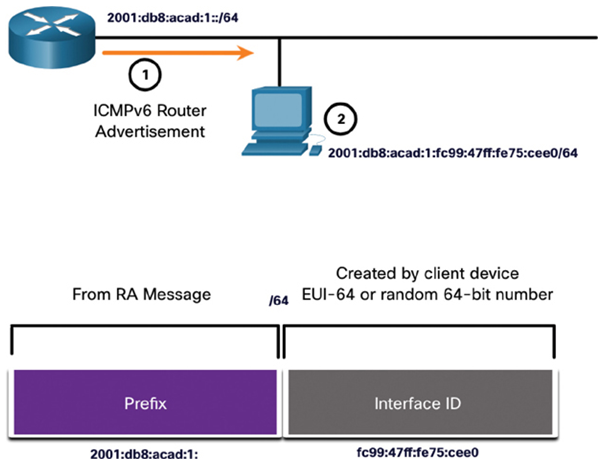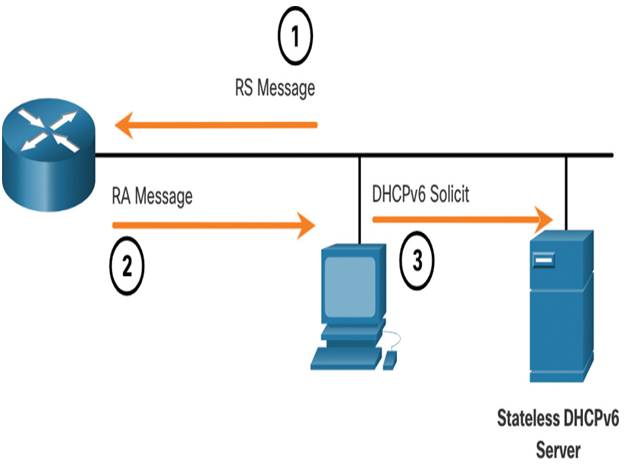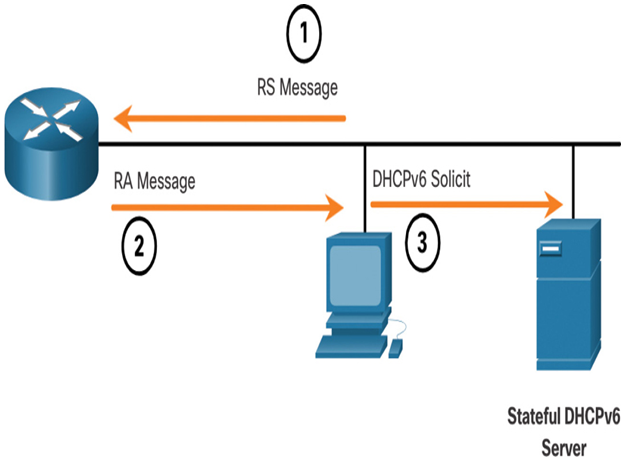Method 1: SLAAC (33.3.2)
Stateless Address Autoconfiguration (SLAAC) is a method that allows a device to create its own GUA without the services of DHCPv6. Using SLAAC, devices rely on the ICMPv6 RA messages of the local router to obtain the necessary information.
By default, the RA message suggests that the receiving device use the information in the RA message to create its own IPv6 GUA and all other necessary information. The services of a DHCPv6 server are not required.
SLAAC is stateless, which means there is no central server (for example, a stateful DHCPv6 server) allocating GUAs and keeping a list of devices and their addresses. With SLAAC, the client device uses the information in the RA message to create its own GUA. As shown in Figure 33-11, the two parts of the address are created as follows:
- Prefix—This is advertised in the RA message.
- Interface ID—This uses the EUI-64 process or by generating a random 64-bit number, depending on the device operating system.

Figure 33-11 SLAAC Example
- The router sends an RA message with the prefix for the local link.
- The PC uses SLAAC to obtain a prefix from the RA message and creates its own Interface ID.
Method 2: SLAAC and Stateless DHCPv6 (33.3.3)
A router interface can be configured to send a router advertisement using SLAAC and stateless DHCPv6.
As shown in Figure 33-12, with this method, the RA message suggests devices use the following:
- SLAAC to create its own IPv6 GUA
- The router LLA, which is the RA source IPv6 address, as the default gateway address
- A stateless DHCPv6 server to obtain other information such as a DNS server address and a domain name
Note
A stateless DHCPv6 server distributes DNS server addresses and domain names. It does not allocate GUAs.

Figure 33-12 SLAAC and Stateless DHCPv6 Example
- The PC sends an RS to all IPv6 routers, “I need addressing information.”
- The router sends an RA message to all IPv6 nodes with Method 2 (SLAAC and DHCPv6) specified. “Here is your prefix, prefix length, and default gateway information. But you will need to get DNS information from a DHCPv6 server.”
- The PC sends a DHCPv6 Solicit message to all DHCPv6 servers. “I used SLAAC to create my IPv6 address and get my default gateway address, but I need other information from a stateless DHCPv6 server.”
Method 3: Stateful DHCPv6 (33.3.4)
A router interface can be configured to send an RA using stateful DHCPv6 only.
Stateful DHCPv6 is similar to DHCP for IPv4. A device can automatically receive its addressing information including a GUA, prefix length, and the addresses of DNS servers from a stateful DHCPv6 server.
As shown in Figure 33-13, with this method, the RA message suggests devices use the following:
- The router LLA, which is the RA source IPv6 address, for the default gateway address.
- A stateful DHCPv6 server to obtain a GUA, DNS server address, domain name, and other necessary information.

Figure 33-13 Stateful DHCPv6 Example
- The PC sends an RS to all IPv6 routers, “I need addressing information.”
- The router sends an RA message to all IPv6 nodes with Method 3 (Stateful DHCPv6) specified, “I am your default gateway, but you need to ask a stateful DHCPv6 server for your IPv6 address and other addressing information.”
- The PC sends a DHCPv6 Solicit message to all DHCPv6 servers, “I received my default gateway address from the RA message, but I need an IPv6 address and all other addressing information from a stateful DHCPv6 server.”
A stateful DHCPv6 server allocates and maintains a list of which device receives which IPv6 address. DHCP for IPv4 is stateful.
Note
The default gateway address can only be obtained dynamically from the RA message. The stateless or stateful DHCPv6 server does not provide the default gateway address.
